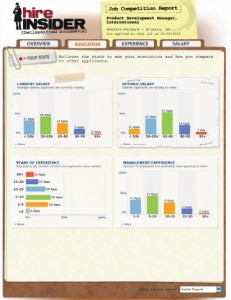 A few weeks ago, after President Obama announced new hiring rules for the federal government, ERE members worked him over pretty hard for insisting that job seekers be treated with courtesy.
A few weeks ago, after President Obama announced new hiring rules for the federal government, ERE members worked him over pretty hard for insisting that job seekers be treated with courtesy.
After 45 comments, the community settled down into camps: Group one is on the side of communicating with job seekers to at least acknowledge receipt of their application and to tell them when they are no longer being considered; group two seems to believe it would be a nice thing, but it’s too much trouble.
No doubt CareerBuilder would rather not get into that debate, and will probably wish I never mentioned federal hiring and them in the same post, but it does provide some perspective on the job board’s newest job seeker tool, hireINSIDER.
hireINSIDER provides a remarkable degree of transparency to job seekers about their competition. An applicant going through CareerBuilder to respond to a job posting can now find out how they compare on several fundamental metrics to others who also applied through CareerBuilder.
 Applicants with a CareerBuilder account can get a Job Competition Report providing them with a summary of the number of candidates who applied and how they stack up on:
Applicants with a CareerBuilder account can get a Job Competition Report providing them with a summary of the number of candidates who applied and how they stack up on:
- Level of education;
- Years of experience;
- Average current salaries;
- Top college majors of applicants;
- Top languages spoken;
- Employment status;
- How many applicants submitted a cover letter.
Obviously, CareerBuilder is only able to provide this information from candidates who applied by using the resume and other data they stored as part of their CB profile. Candidates who applied otherwise won’t be part of the data summary.
That’s still a boatload more information than candidates ever get. And for those candidates who want to know the status of the hiring process, they can sign up for a report. They share their own status in the hiring process and in exchange are updated on what the other candidates have heard. Which, might just be nothing, since CareerBuilder pointed out that in a survey conducted by Personified, its consulting and RPO division, 60 percent of the job seekers polled said they never heard from employers to whom they apply.
For job seekers, the benefits are palpable. If you have only three years experience and most of the other candidates have six or seven or more, that helps explain why you didn’t get a call from a recruiter. (There might be other reasons, certainly.)
For employers, the program is equally as valuable, and not just because it can reduce those annoying calls and emails asking if a resume was even received.
“hireINSIDER also benefits employers who may not have the time or resources to respond to an increasing amount of applications in a tough economy,” says Brent Rasmussen, president of CareerBuilder North America. “By providing the feedback that job seekers need, it helps to alleviate the negative impact that a lack of response can have on a company’s employment brand.”
This is by no means the first attempt to address the black hole problem. Three years ago Monster introduced an expanded “Apply History” which allowed job seekers to at least know that their application was sent and retrieved by an employer. Monster also provided job seekers with data on how the applicant pool compares on education and experience.
Since then, Monster has introduced additional career planning tools, including an ever-improving career mapping function that lets candidates see what routes others have taken to get to where they are.
hireINSIDER ups the ante on what job seekers can learn. Besides the free reports, seekers willing to spend money can buy a more detailed report covering management experience, number of direct reports, popular companies worked for, recent industries worked in, popular colleges attended, and more.